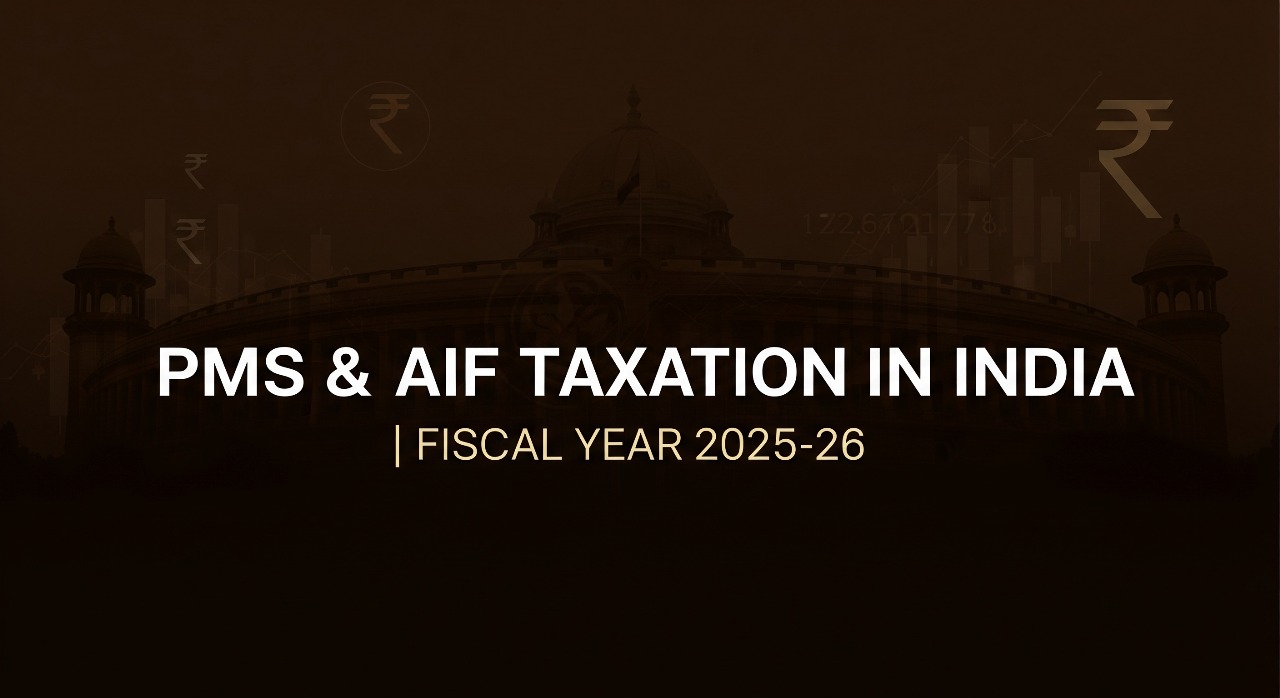Introduction
For savvy investors exploring Portfolio Management Services (PMS) or Alternative Investment Funds (AIFs), tax treatment is a critical — and often overlooked — factor that impacts net returns. Both structures provide professional fund management but tax income, gains, and fees differently.
This page provides a detailed, easy-to-understand comparison of PMS vs AIF taxation — updated for FY 2024–25.
PMS Taxation – Direct, Transparent, and Investor-Led
Structure:
In PMS, you hold assets in your name (Demat account) without pooling funds.
Tax Treatment:
| Component | Taxed By | Tax Rate / Rule |
| Short-Term Capital Gains (Equity ≤ 1 yr) | Investor | 20% + surcharge & cess |
| Long-Term Capital Gains (Equity > 1 yr) | Investor | 12.5% above ₹1 lakh |
| Unlisted Bonds / Debt | Investor | STCG – slab rate; LTCG – 12.5 |
| Dividend Income | Investor | Taxed as per slab (TDS @10% if >₹5,000) |
| Interest Income | Investor | Taxed under “Other Sources” |
Deductions:
- You can claim PMS fees (excluding STT/GST) as deductions against capital gains.
- The service provider must bill these fees separately and usually allows them in non-discretionary PMS.
Tax Filing & Advance Tax:
- Investors must file taxes under ITR-2 or ITR-3
- Advance tax applies if annual liability exceeds ₹10,000
AIF Taxation Overview – Varies by Category
Category I AIF – Tax Pass-Through (e.g., VC, SME, infra funds)
- The fund does not pay tax
- You pay tax directly on the income you receive.
- The tax department applies capital gains tax based on the holding period (e.g., LTCG after 2 years for equity at 12.5%, STCG gets added to your income tax slab).
AIF Category II – Tax Pass-Through (e.g., real estate, private credit, equity long-only)
- Same structure as Category I
- Income is taxed based on the nature of the underlying assets
Key Notes:
- Investors get audited statements for tax filing
- The fund does not pay tax at the entity level
- No expense deductions allowed for investors
AIF Category III – Taxed at Fund Level (e.g., hedge funds, long-short)
- Fund pays tax before distributing income
- Tax rate remains the same.
- Maximum Marginal Rate (~42.74%) applied to all gains and income generated by derivatives
- Investors receive post-tax returns
- No TDS or tax filing requirement for investors
Capital Gains Holding Periods (For AIF & PMS)
| Asset Class | Short-Term Holding Period | Long-Term Holding Period |
| Listed Equity | ≤ 12 months | > 12 months |
| Unlisted Equity / Debt | ≤ 36 months | > 36 months |
Key Tax Concepts for AIF & PMS Investors
Pass-Through Taxation (Cat I & II AIFs, PMS)
Income flows directly to investors. You must:
- Declare capital gains and interest income
- Pay tax based on the type and holding period
Taxed-at-Fund Level (Cat III AIFs)
- The investor doesn’t pay tax or file separately
- Fund pays taxes and distributes post-tax proceeds
If you’re focused on maximizing post-tax returns and comfortable with filing, PMS and Cat II AIFs can offer an edge. If you prefer ease, Category III AIFs provide administrative convenience — at a cost.
PMS vs AIF Taxation Summary
| Aspect | PMS | AIF Category I & II | AIF Category III |
| Structure | Direct (Demat in investor’s name) | Pooled, pass-through | Pooled, taxed at the fund level |
| Tax on Capital Gains | Investor pays directly (12.5–20%) | Investor pays directly (12.5 – Income tax slab) | Fund pays taxes at the same rate |
| Tax on Interest Income | Taxed at the investor’s slab | Taxed at the slab | Taxed fund level |
| Dividend Tax | Taxed at slab rate, no TDS | Taxed at the hands of the investor | Taxed at the fund level |
| Claiming Expenses | Allowed (for capital gains) | Not allowed | Not allowed |
| Tax Filing Responsibility | Investor | Investor | Fund |
How PMS AIF WORLD Helps
At PMS AIF WORLD, we go beyond fund discovery. We help you:
- Compare post-tax performance of PMS vs AIFs
- Understand TDS, reporting, and tax obligations
- Choose structures that suit your income profile and risk appetite
- Coordinate with your CA for seamless tax planning
Disclaimer: Securities investments are subject to market risks and there is no assurance or guarantee that the objective of the investments will be achieved. The statements contained herein may include statements of future expectations and other forward-looking statements that are based on our current views and assumptions and involve known and unknown risks and uncertainties that could cause actual results, performance or events to differ materially from those expressed or implied in such statements
Do Not Simply Invest, Make Informed Decisions
WISH TO MAKE INFORMED INVESTMENTS FOR LONG TERM WEALTH CREATION


